Chapter: Biochemistry: Nucleic Acids: How Structure Conveys Information
Are there other possible conformations of the double helix?
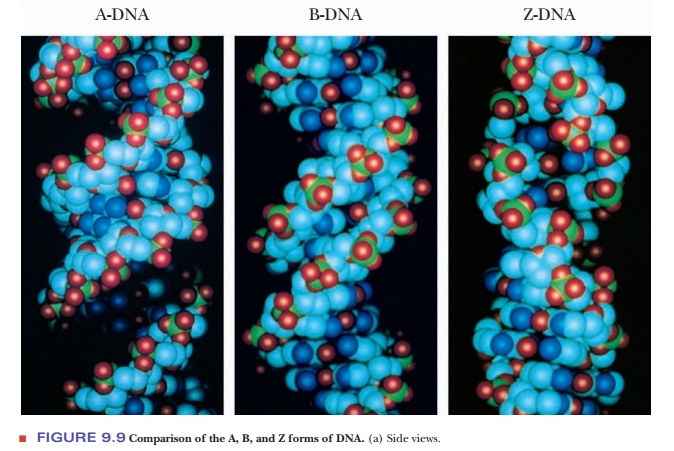
Are there other possible conformations of the double helix?
The form of DNA that we have been discussing so far is called B-DNA. It is thought to be the principal form that occurs in nature.
However, other secondary structures can occur, depending on conditions such as the nature of the positive ion associated with the DNA and the specific sequence of bases. One of those other forms is A-DNA, which has 11 base pairs for each turn of the helix. Its base pairs are not perpendicular to the helix axis but lie at an angle of about 20° to the perpendicular (Figure 9.9). An important shared feature of A-DNA and B-DNA is that both are right-handed helices; that is, the helix winds upward in the direction in which the fingers of the right hand curl when the thumb is pointing upward (Figure 9.10).
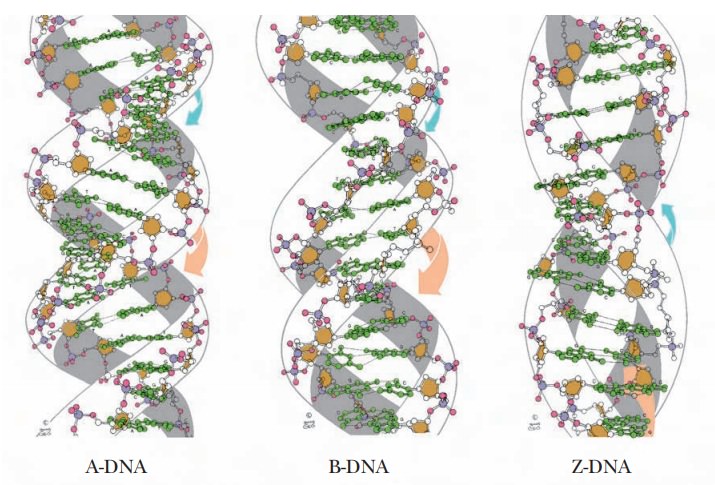
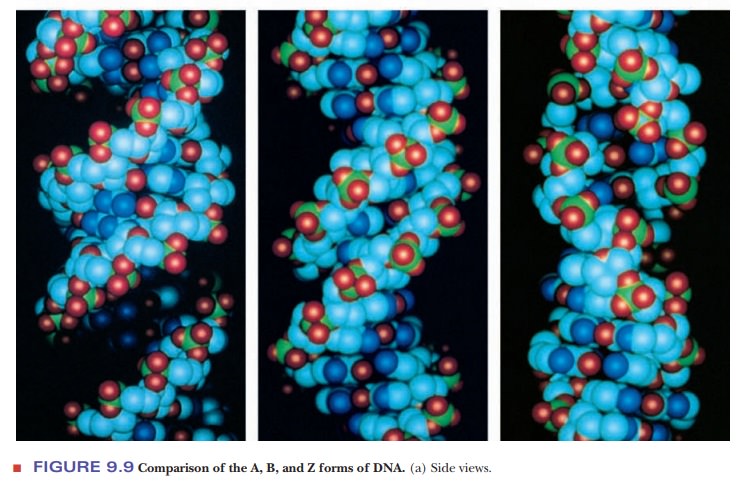
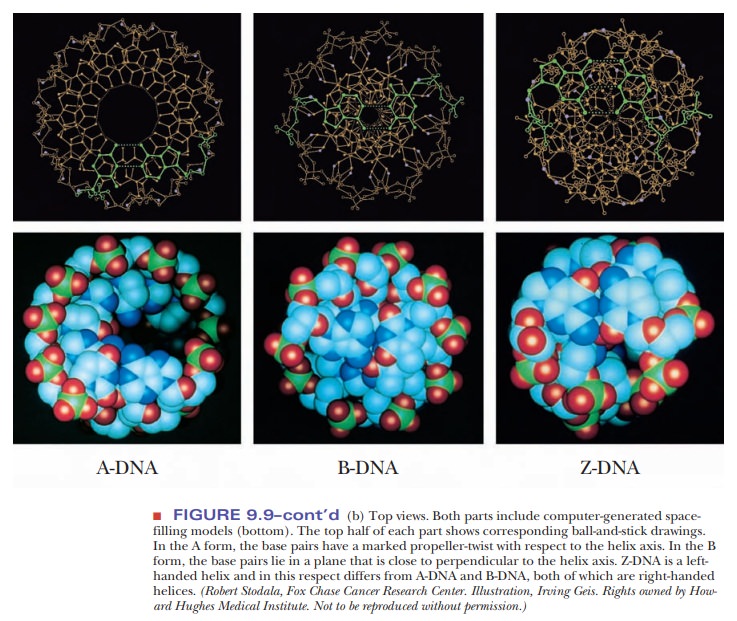
The A form of DNA was originally found in dehydrated DNA samples, and many researchers believed that the A form was an artifact of DNA preparation. DNA:RNA hybrids can adopt an A formation because the 2'-hydroxyl on the ribose prevents an RNA helix from adopting the B form; RNA:RNA hybrids may also be found in the A form.

Another variant form of the double helix, Z-DNA, is left-handed; it winds in the direction of the fingers of the left hand (Figure 9.10). Z-DNA is known to occur in nature, most often when there is a sequence of alternating purine– pyrimidine, such as dCpGpCpGpCpG. Sequences with cytosine methylated at the number 5 position of the pyrimidine ring can also be found in the Z form. It may play a role in the regulation of gene expression. The Z form of DNA is also a subject of active research among biochemists. The Z form of DNA can be considered a derivative of the B form of DNA, produced by flipping one side of the backbone 180° without having to break either the backbone or the hydrogen bonding of the complementary bases. Figure 9.11 shows how this might occur. The Z form of DNA gets its name from the zigzag look of the phosphodiester backbone when viewed from the side.
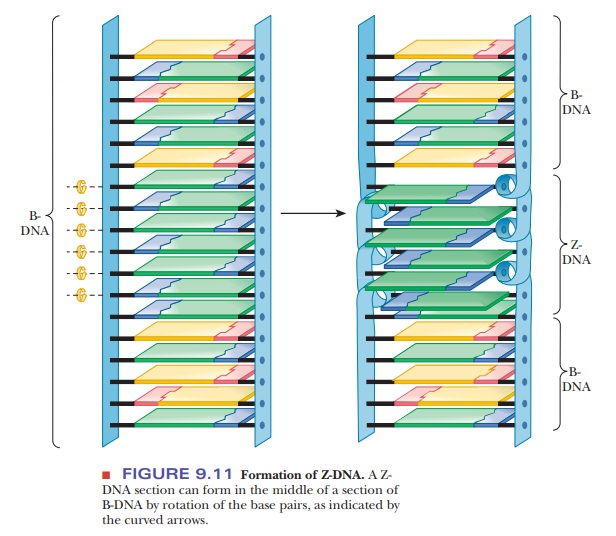
The B form of DNA has long been considered the normal, physiological DNA form. It was predicted from the nature of the hydrogen bonds between purines and pyrimidines and later found experimentally. Although it is easy to focus completely on the base pairing and the order of bases in DNA, other features of DNA structure are just as important. The ring portions of the DNA bases are very hydrophobic and interact with each other via hydrophobic bonding of their pi-cloud electrons.
This process is usually referred to as base stack-ing, and even single-stranded DNA tends to form structures in which the basescan stack. In standard B-DNA, each base pair is rotated 32° with respect to the preceding one (Figure 9.12). This form is perfect for maximal base pairing, but it is not optimal for maximal overlap of the bases. In addition, the edges of the bases that are exposed to the minor groove must come in contact with water in this form. Many of the bases twist in a characteristic way, called propeller-twist (Figure 9.13). In this form, the base-pairing distances are less optimal, but the base stacking is more optimal, and water is eliminated from the minor-groove contacts with the bases. Besides twisting, bases also slide sideways, allowing them to interact better with the bases above and below them. The twist and slide depends on which bases are present, and researchers have identified that a basic unit for studying DNA structure is actually a dinucleotide with its com-plementary pairs. This is called a step in the nomenclature of DNA structure. For example, in Figure 9.13, we see an AG/CT step, which tends to adopt a dif-ferent structure from a GC/GC step. As more and more is learned about DNA structure, it is evident that the standard B-DNA structure, while a good model, does not really describe local regions of DNA very well. Many DNA-binding proteins recognize the overall structure of a sequence of DNA, which depends upon the sequence but is not the DNA sequence itself.
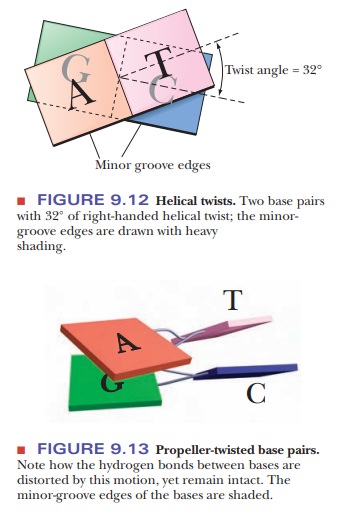
Recent research has implicated cruciform DNA structures, triple helices, and Z-DNA in life processes (Figure 9.14a). Suggestions have been made that quadruplex DNA exists and that it plays a role in halting transcription (Figure 9.14b).
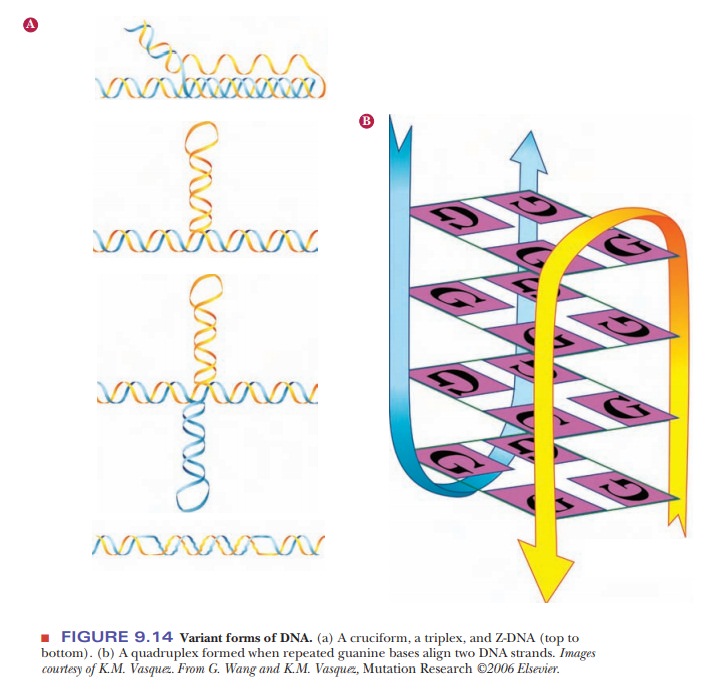
The DNA molecule has a length considerably greater than its diameter; it is not completely stiff and can fold back on itself in a manner similar to that of proteins as they fold into their tertiary structures. The double helix we have discussed so far is relaxed, which means that it has no twists in it, other than the helical twists themselves. Further twisting and coiling, or supercoiling, of the double helix is possible.
Related Topics